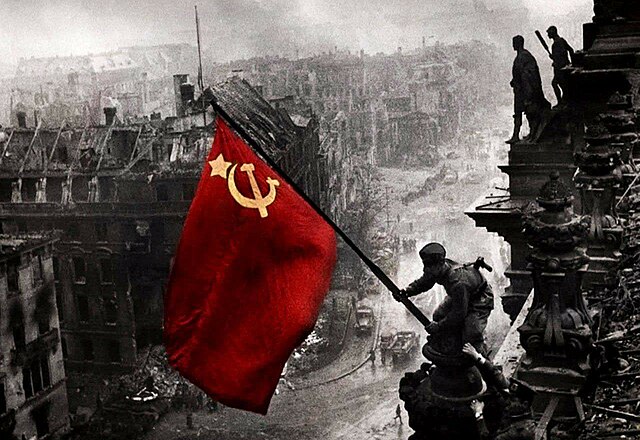For three years, Nathaniel Flakin has been publishing a weekly column on Berlin politics called “Red Flag.” It just moved to a new home at the newspaper ND. theleftberlin has just agreed with ND that we will also be publishing the column. In preparation for this, we interviewed Nathaniel.
Can you tell us about your column “Red Flag”?
Berlin’s English-speaking community is growing constantly. But a lot of the city’s left-wing politics, as well as its radical history, are still only available in German. Just like this website is doing, I’m trying to offer local communist content so that people can better understand campaigns and struggles.
I think when people hear about a red flag in Berlin, they will picture the Soviet flag waving over the Reichstag in 1945. And for sure, that was a spectacular moment in Berlin history. Spasiba! But I was actually thinking of a different red flag…
A bit more than a century ago, on November 9, 1918, there was a an insurrection in Berlin. That evening, friends of Rosa Luxemburg — who called themselves Spartacists — went to the biggest, most right-wing tabloid in the city. After occupying the building, they informed the journalists that this would now be a communist paper. “There has just been a successful revolution, gentlemen,” Hermann Duncker said, “and you will understand that it cannot tolerate a counterrevolutionary press.” Thus, Die Rote Fahne or The Red Flag was born.
The first issue was titled: “Berlin Under the Red Flag.” Rosa Luxemburg is usually credited as the founder. But she only arrived the next day to edit the second issue. She had been in prison and it wasn’t easy to get back to Berlin.
With the name “Red Flag,” I was trying to connect to this history of anti-capitalist journalism in Berlin.
What do you write about in your column?
In recent columns, I have discussed the second referendum to expropriate big landlords or about the orange paint on the Brandenburg Gate. In general, I write about racist police violence, car culture’s poisonous effects, and the ecocidal hypocrisy of the so-called Green Party. I also like reporting about strikes and workers’ struggles, even if those don’t get as many hits. I believe my most popular column was about the racist moral panic whipped up after the Silvester Riots.
I never believed that journalists should be neutral. In fact, on my very first day working as a journalist, at a left-wing paper, my boss told me: “Objectivity is a bourgeois myth!” Wise words. Every journalist has convictions — most of them support capitalism — so it’s a question of respect for our readers to be open about our views.
When did you start publishing the column?
I started writing the column for the Exberliner website back in 2020. They were never big fans of socialism, but I think they loved the controversies and the clicks that “Red Flag” generated. More recently, they decided that my endless stream of communist propaganda didn’t fit their brand. And I get it: I also mostly want Exberliner to tell me about fun things going on in the city, not calling on the proletariat to take up arms. Exberliner still publishes my history column in the print edition, and I have been able to do some deep dives about Clara Zetkin’s former home or about Magnus Hirschfeld’s Institute for Sexual Science. Exberliner is an institution that keeps a lot of Berlin’s English-speaking community together.
Where did you find a new home for the column?
ND! Have you heard of ND? It’s probably not very well known to English speakers. Back in 1946, Neues Deutschland was created as the central organ of the Socialist Unity Party (SED). The idea was that they wanted a “New Germany” free of Nazis, aristocrats, and militarists. It eventually became the main paper of the German Democratic Republic (GDR), selling a million copies a day. This was before my time, but Neues Deutschland had a reputation for the forced optimism typical of Stalinist regimes. Victor Grossman recalls a joke: If Australia were to sink into the Indian Ocean, the headline in ND would read that the plan for steel had been fulfilled, while the disappearance of a continent would get a short mention on page 5.
After reunification, Neues Deutschland was owned by the PDS and then DIE LINKE, while trying to maintain an independent socialist profile. Back in 2021, it was converted into a Genossenschaft, a cooperative, where many journalists and readers now own shares, and decisions are made democratically. ND is the the only left-wing paper that manages to report in detail from inside Berlin’s parliament and district councils.
ND still works out of the Neues Deutschland building at Franz-Mehring-Platz, now an event space known as FMP1. They also have a spectacular archive — I consulted with them, for example, looking for unpublished photos of Angela Davis’s visits to East Berlin in the early 1970s.
What is the status of ND now?
Their first year as a cooperative was very difficult — they ended up €600,000 in the red. But a solidarity campaign has collected over €150,000 to keep this important left-wing institution running.
Today, ND is a broad left paper. I certainly don’t agree with everything they publish — and I know some of their journalists don’t agree with me either. There is plenty of debate. Some of ND journalists started working there back in the 1980s, while others are young lefties from different organizations.
I’m really happy they are taking a chance with this column — their first content in English. They’ve been translating all my columns to German as well, so now “Red Flag” is bilingual.
